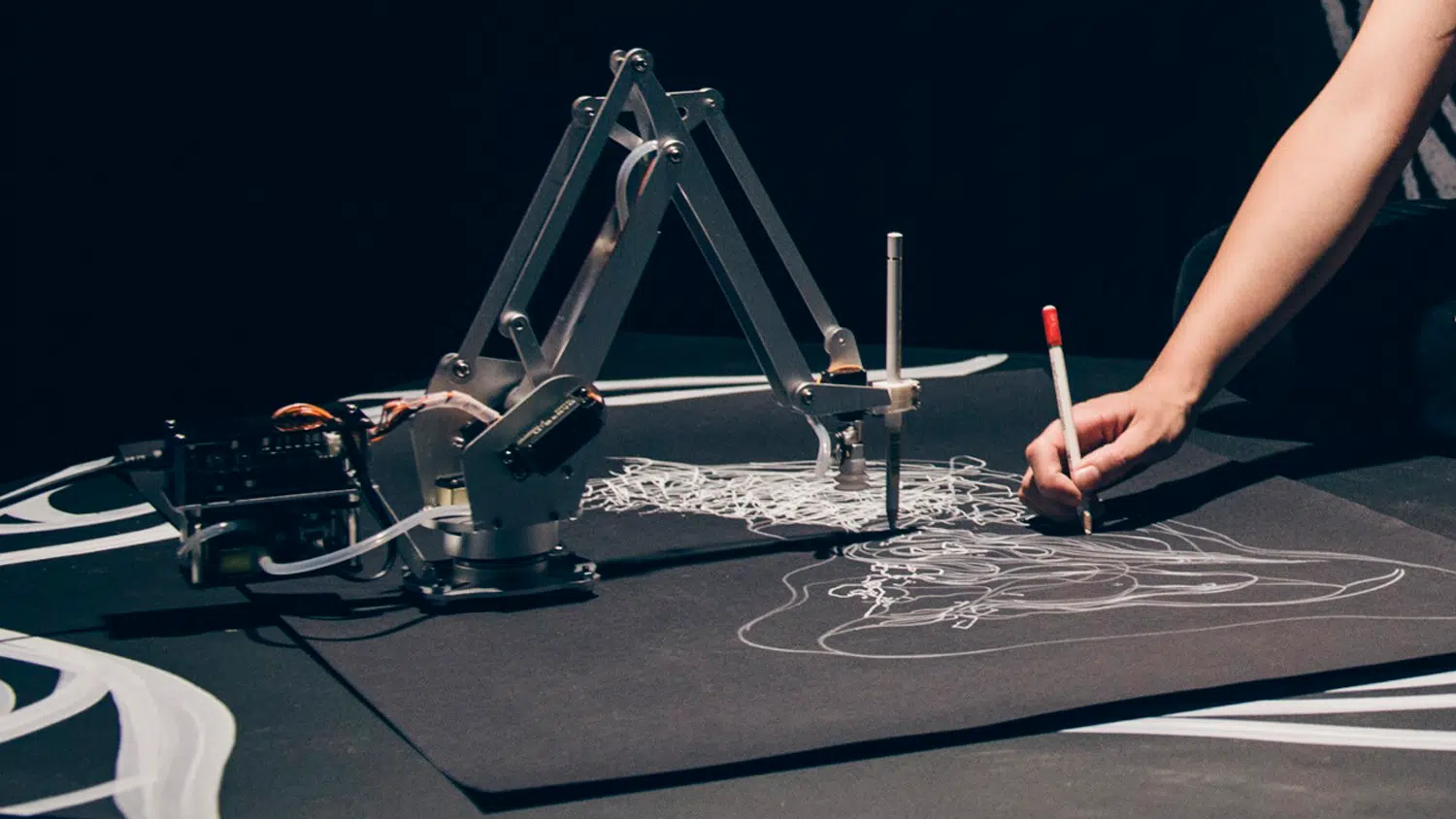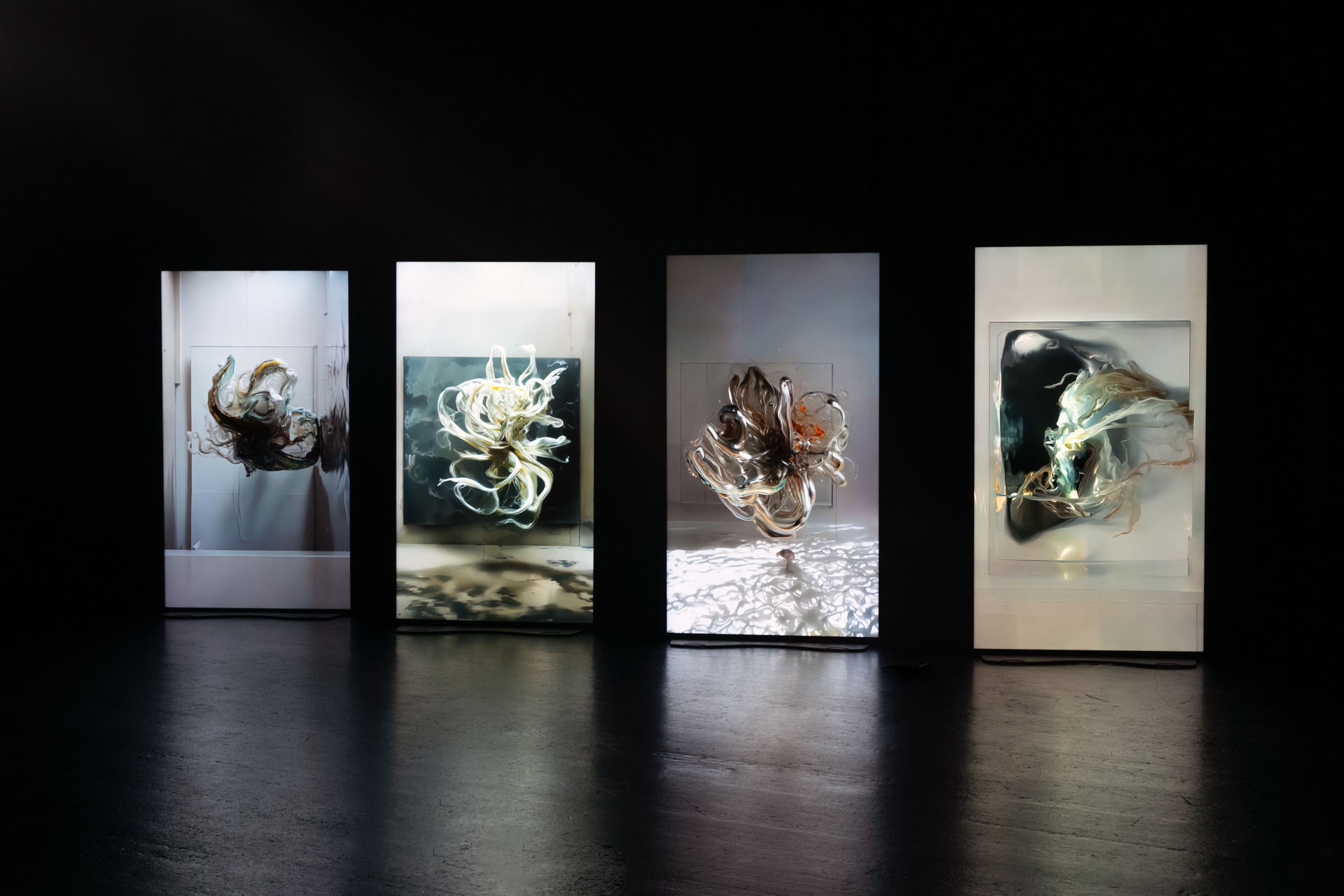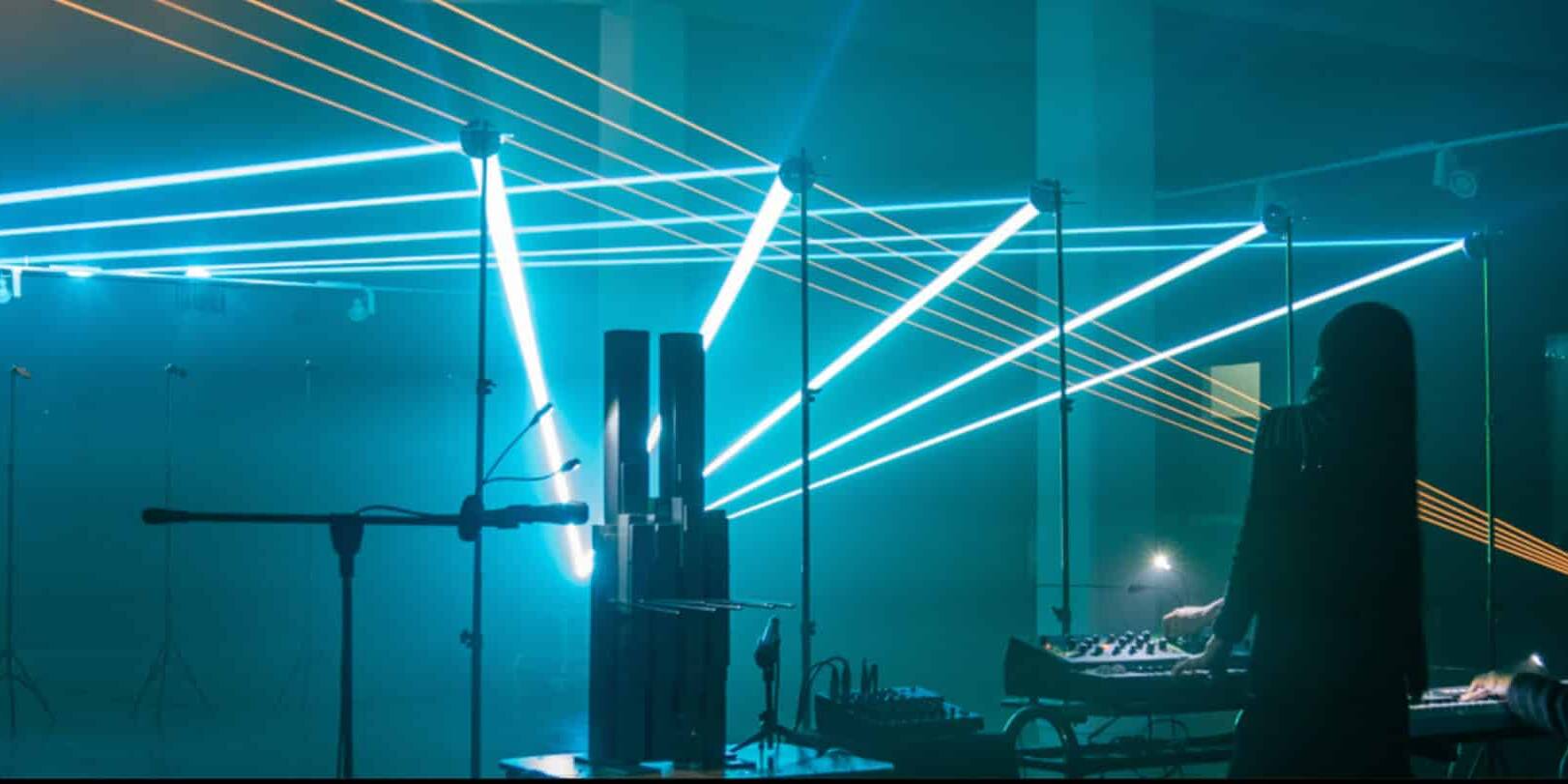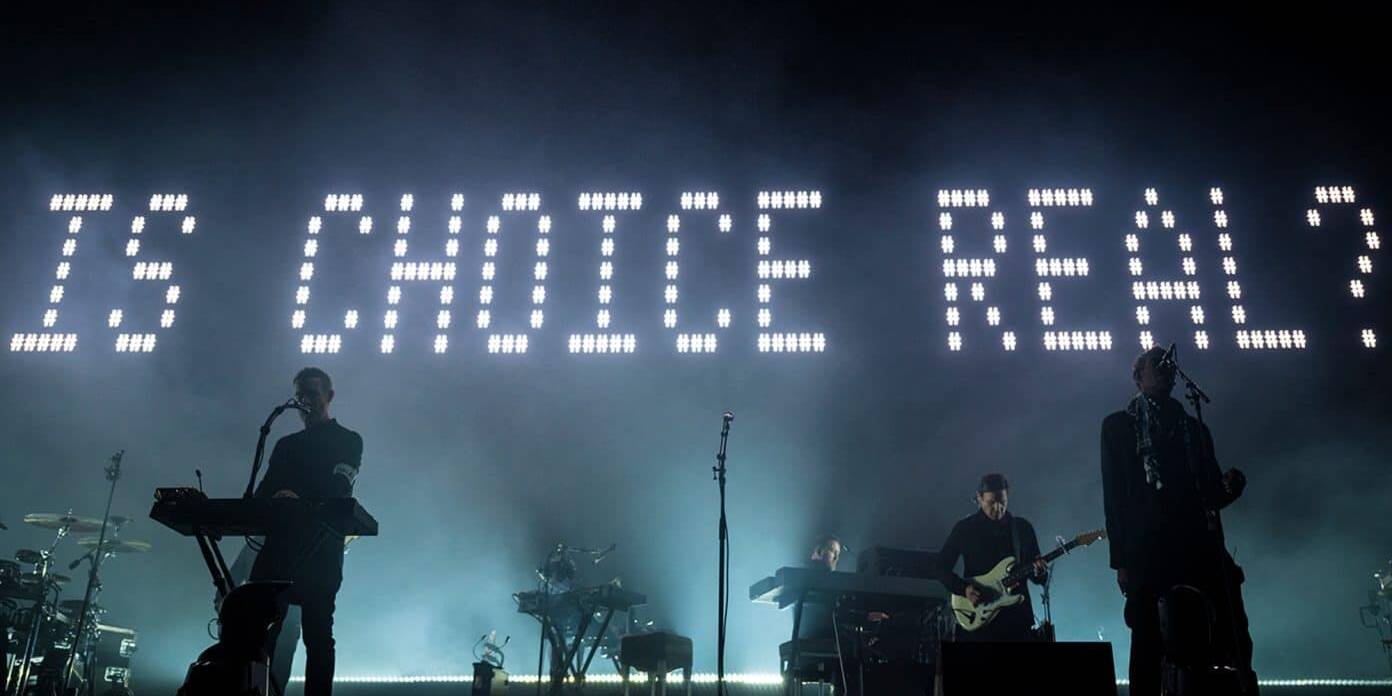“Technology not as a tool, but as a collaborator.”
Many artists and researchers hold an optimistic view regarding the potential of artificial intelligence, firmly believing that the path to the future lies in close collaboration between humans and machines. For them, co-creation not only expands creative possibilities but also offers new ways to explore and transform knowledge and artistic expression.
Operating under the premise: “When we can begin to see that the systems we build are actually us in another form, in another mode of temporality, then we will move towards a multiplicity of intelligences and approaches to intelligence,” Sougwen positions herself as a prominent figure in this field.
Sougwen 愫君 Chung is active in both artistic and research domains, focusing on human-machine collaboration. Of Chinese-Canadian descent, her work explores hand-made and machine-generated marks as a means to analyze the interaction between humans and systems. Her piece MEMORY (Drawing Operations Unit: Generation 2) is part of the Victoria and Albert Museum’s permanent collection, being the first AI model incorporated by a major institution. This recognition adds to her inclusion as a Cultural Leader at the World Economic Forum and among the 100 most influential people in AI according to TIME. TIME.
Chung has exhibited internationally at venues such as the Espoo Museum of Modern Art; the Vancouver Art Gallery; Art Basel Miami; the National Art Center in Tokyo; the NTT [ICC] Tokyo; the ArtScience Museum in Singapore; the MIT Media Lab in Cambridge; the Drawing Center in New York; the New Museum in New York; the Museum of Contemporary Art in Geneva; Mana Contemporary in New York; the Tribeca Film Festival in New York; the Hospital Club in London; the Mutek Festival in Montreal and Mexico City; and Sónar in Barcelona.
She has also been a TED speaker for several editions and is part of the research team at the MIT Media Lab. She has participated in international conferences such as the United Nations in Geneva; the World Economic Forum in China; Oxford University; the SIGGRAPH Conference in Vancouver; the Global Art Forum in Singapore; the World Science Festival in New York; and Cannes Lions in Cannes, among many others.

In a conversation with Forbes, she mentioned:
“Human-machine collaboration is a perspective of technology not as a tool, but as a collaborator. What does this mean? It stems from understanding that the relationship between humans and their tools has changed. Digital tools are different from tools like a hammer, for example. They are editable, fluid, clearly fallible, or all of the above. Screen-based tools change and receive updates in a way that doesn’t happen with physical tools. Think of Photoshop vs. a paintbrush.”
“And nowadays, with the predictive nature of AI systems, which are based on user data, tools are informed by us. By the user through collected data, by the designer’s intention, and by technological trends, processing capacity, and a host of other factors. I find it interesting because modern tools have a responsiveness that prevails in concepts as common as autosuggestion and autocorrection. This feedback loop between human, tool, and system radically changes the creation process. The canvas is no longer blank but suggests things and pushes you. It complicates authorship and goes beyond creative activities, extending to everyday use of technology. Depending on your perspective, this is exciting or uncomfortable.”
Her current artistic exploration revolves around using robots as collaborators. In her Ted Talk she asks, “What happens when humans and robots create art together?” and shows how she “taught” her artistic style to a machine. Upon sharing the results of their collaboration, she realizes that robots also make mistakes.
Here is a selection of her most notable works:

BODY MACHINE (MERIDIANS)
It is a series of biomimetic robotic speculations, sculpted in the air, that reimagine machines as extensions of living systems. The concept of the meridian is woven throughout the series as both a planetary measurement and a pathway of the body.
Through this dual meaning, the viewer is invited to reflect on bodies—bodies in motion, machine forms, and terrestrial biomes—exploring how these three can intertwine.
Each piece is drawn in the air, comparing the spatial act of drawing to the flow of energy within meridians, embodied states of flow. The data collected from these movements embody a convergence of intention, energy, and spatial presence, tracing not only the artist’s hand but also the interaction of the entire body with different scales, as if pathways were being mapped across the planet itself.
Two types of Machine Meridians emerge in this work: Cybernetic and Biomimetic. Cybernetic meridians represent artificial computational systems, while biomimetic meridians are inspired by organic ecosystems. These meridians are further divided into macro and microbiomes. Macrobiomes—forests, deserts, and glaciers—define large-scale environments, while microbiomes represent more granular and intricate systems, both cybernetic and biomimetic.
GENESIS
It is an ongoing research project that explores the evolution of
the drawn line and robotic form. It begins with a collection of speculative machine constructions inspired by living organisms. The process, form, and dataset of GENESIS are designed to drive the development of posthuman collaboration and the creation of symbiotic machines.
A virtual avatar of Sougwen Chung guides the creation of each sculpture, immersing the viewer in a seamless virtual spectacle that culminates in the captivating representation of an abstract serpent within the first installation.
The intricate 3D gestural expressions come to life through various fabrication techniques, ranging from large-format 3D printing to custom chroming.
The result is a process that speculates on the dissolution of boundaries between architecture, drawing, and dance. The serpentine form, suspended within the space, mirrors the texture of liquid mercury, and its contours reflect the intricate processes embedded in the surrounding walls.
Beyond the perception of the relationship between mark-making and image, the incorporation of infrared and positional sensors into the virtual reality software lays the groundwork for a novel integration of bodily cognitive processes.

ASSEMBLY LINES
It is a performative installation featuring a custom multi-robotic system driven by meditation and biofeedback.
The machine system is a technological configuration that goes beyond automation, exploring the instinctive rhythms of painting through human and mechanical co-creation. It intertwines the gestural authorship of both biological and mechanical subjects within the space.
The echo of the collaboration between the artist and the robot is transposed through an octophonic sound system. Placed throughout the room, the sound immerses the audience in a multisensory environment, creating a composition of neuronal and synaptic gestures.
How can we alter our experience of time through a shared ritual?
What new relational perspectives can emerge when human subjects and machines create on the same plane?


